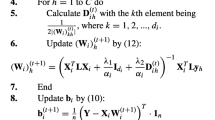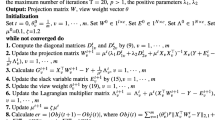Abstract
This paper proposes a new multi-view classification method by taking three sample constraints into account to automatically assign large weights to important samples and small weights to unimportant samples. To do this, we first demonstrate that different samples have different contributions to the classification models, and then propose to consider sample weight, class weight, and view weight, to overcome the influence of different levels of noise. Specifically, the sample weight for every data point is obtained by penalizing an \(\ell _{2,1}\)-norm loss on its estimation error to reduce the influence of the sample-level noise, the class weight for each class is obtained by considering the misclassification cost as well as imbalance class to overcome the influence of class-level noise, and the view weight for each view is obtained by penalizing a squared root operator on the estimation error of each view to reduce the influence of view-level noise. In particular, our proposed sample constraints can be easily embedded in previous multi-view learning models. Experimental results on simulated and real data sets showed that our proposed method was superior to the state-of-the-art classification methods in terms of classification performance of cost-sensitive learning.



Similar content being viewed by others
References
Wang H, Nie F, Huang H (2013) “Multi-view clustering and feature learning via structured sparsity,” In: International conference on machine learning.PMLR, pp. 352–360
Cai X, Nie F, Huang H (2013) “Multi-view k-means clustering on big data,” In: IJCAI, pp. 2598–2604
Yang M, Deng C, Nie F (2018) Adaptive-weighting discriminative regression for multi-view classification. Pattern Recogn 88(2019):236–245
Shen HT, Liu L, Yang Y, Xu X, Huang Z, Shen F, Hong R (2020) Exploiting subspace relation in semantic labels for cross-modal hashing. IEEE Trans Knowledge Data Eng. https://doi.org/10.1109/TKDE.2020.2970050
Zhu X, Yang J, Zhang C, Zhang S (2019) Efficient utilization of missing data in cost-sensitive learning. IEEE Trans Knowledge Data Eng. https://doi.org/10.1109/TKDE.2019.2956530
Zhu X, Gan J, Lu G, Li J, Zhang S (2019) “Spectral clustering via half-quadratic optimization,” World Wide Web, pp. 1–20
Hu R, Zhu X, Zhu Y, Gan J (2020) Robust svm with adaptive graph learning. World Wide Web 23(3):1945–1968
Zha Z, Yang Y, Tang J, Wang M, Chua T (2015) Robust multiview feature learning for RGB-D image understanding. ACM TIST 6(2):15:1-15:19
Xu X, Lu H, Song J, Yang Y, Shen HT, Li X (2019) “Ternary adversarial networks with self-supervision for zero-shot cross-modal retrieval,”
Liu H, Mao H, Fu Y (2016) “Robust multi-view feature selection,” In: ICDM, pp. 281–290
Khan SH, Hayat M, Bennamoun M, Sohel FA, Togneri R (2015) Cost-sensitive learning of deep feature representations from imbalanced data. IEEE Trans Neural Netw Learn Syst 29(8):3573–3587
Thai-Nghe N, Gantner Z, Schmidt-Thieme L (2010) “Cost-sensitive learning methods for imbalanced data,” In: IJCNN, pp. 1–8
Zhang Z, Liu L, Shen F, Shen HT, Shao L (2019) Binary multi-view clustering. IEEE Trans Pattern Anal Mach Intell 41(7):1774–1782
Shen HT, Zhu X, Zhang Z, Wang S-H, Chen Y, Xu X, Shao J (2021) Heterogeneous data fusion for predicting mild cognitive impairment conversion. Inf Fus 66:54–63
Nie F, Tian L, Li X (2018) “Multiview clustering via adaptively weighted procrustes,” In: KDD, pp. 2022–2030
Ding Z, Fu Y (2016) “Robust multi-view subspace learning through dual low-rank decompositions,” In: AAAI, pp. 1181–1187
Zhang C, Tan KC, Li H, Hong GS (2019) A cost-sensitive deep belief network for imbalanced classification. IEEE Trans Neural Netw Learn Syst 30(1):109–122
Zhu X, Zhang S, Zhu Y, Zhu P, Gao Y (2020) Unsupervised spectral feature selection with dynamic hyper-graph learning. IEEE Trans Knowl Data Eng. https://doi.org/10.1109/TKDE.2020.3017250
Lapedriza A, Pirsiavash H, Bylinskii Z, Torralba A (2013) “Are all training examples equally valuable?”arXiv:1311.6510arXiv preprint
Jiang L, Meng D, Yu S-I, Lan Z, Shan S, Hauptmann A (2014) “Self-paced learning with diversity,” In: Advances in Neural Information Processing Systems, pp. 2078–2086
Zhu X, Li X, Zhang S, Xu Z, Yu L, Wang C (2017) Graph PCA hashing for similarity search. IEEE Trans Multimed 19(9):2033–2044
Du L, Li X, Shen Y-D (2012) “Robust nonnegative matrix factorization via half-quadratic minimization,” In: 2012 IEEE 12th International Conference on Data Mining.IEEE, pp. 201–210
Shen HT, Zhu Y, Zheng W, Zhu X, (2020) “Half-quadratic minimization for unsupervised feature selection on incomplete data,” IEEE Trans Neural Netw Learn Syst
He R, Zheng W, Tan T, Sun Z (2014) Half-quadratic-based iterative minimization for robust sparse representation. IEEE Trans Pattern Anal Mach Intell 36(2):261–275
He Y, Wang F, Li Y, Qin J, Chen B (2019) Robust matrix completion via maximum correntropy criterion and half-quadratic optimization. IEEE Trans Signal Process 68:181–195
Xiong K, Iu HH, Wang S (2020) “Kernel correntropy conjugate gradient algorithms based on half-quadratic optimization,” IEEE Trans Cybern
Feng L, Sun H, Zhu J (2019) Robust image compressive sensing based on half-quadratic function and weighted schatten-p norm. Inf Sci 477:265–280
Nikolova M, Ng MK (2005) Analysis of half-quadratic minimization methods for signal and image recovery. SIAM J Sci Comput 27(3):937–966
Nie F, Huang H, Cai X, Ding CHQ (2010) “Efficient and robust feature selection via joint \(l_{21}\)-norms minimization,” In: NIPS, pp. 1813–1821
Lu G, Zou J, Wang Y, Wang Z (2016) L1-norm-based principal component analysis with adaptive regularization. Pattern Recogn 60:901–907
Xu C, Tao D, Xu C (2013) “A survey on multi-view learning,” Computer Science, pp. 1–59,arXiv:1304.5634
Wang H, Yang Y, Liu B (2019) GMC: Graph-based multi-view clustering. IEEE Trans Knowl Data Eng 32(6):1116–1129
Kumar A, III HD (2011) “A co-training approach for multi-view spectral clustering,” In: ICML, pp. 393–400
Ma F, Meng D, Dong X, Yang Y (2020) Self-paced multi-view co-training. J Mach Learn Res 21(57):1–38
Nie F, Cai G, Li J, Li X (2017) Auto-weighted multi-view learning for image clustering and semi-supervised classification. IEEE Trans Image Process 27(3):1501–1511
Romero D, Ma M, Giannakis GB (2017) Kernel-based reconstruction of graph signals. IEEE Trans Signal Process 65(3):764–778
Wang Z, Zhu C, Niu Z, Gao D, Feng X (2014) Multi-kernel classification machine with reduced complexity. Knowl Based Syst 65:83–95
Chao G, Sun S (2016) Multi-kernel maximum entropy discrimination for multi-view learning. Intell Data Anal 20(3):481–493
Wang Z, Zhu Z, Li D (2020) Collaborative and geometric multi-kernel learning for multi-class classification. Pattern Recogn 99:107050
Li J, Wu Y, Zhao J, Lu K (2017) Low-rank discriminant embedding for multiview learning. IEEE 47(11):3516–3529
Zhu X, Huang Z, Shen HT, Cheng J, Xu C (2012) Dimensionality reduction by mixed kernel canonical correlation analysis. Pattern Recogn 45(8):3003–3016
Yang M, Deng C, Nie F (2019) Adaptive-weighting discriminative regression for multi-view classification. Pattern Recogn 88:236–245
Fan R, Luo T, Zhuge W, Qiang S, Hou C (2020) Multi-view subspace learning via bidirectional sparsity. Pattern Recogn. 108:107524
Nie F, Tian L, Li X (2018) “Multiview clustering via adaptively weighted procrustes,” In: KDD. ACM, pp. 2022–2030
Tucker A, Vinciotti V, Liu X, Garway-Heath D (2005) A spatio-temporal bayesian network classifier for understanding visual field deterioration. Artif Intell Med 34(2):163–177
Sheng VS, Ling CX (2006) “Thresholding for making classifiers cost-sensitive,” In: AAAI, pp. 476–481
Elkan C (2001) “The foundations of cost-sensitive learning,” In: IJCAI, pp. 973–978
Castro CL, de Pádua Braga A (2013) Novel cost-sensitive approach to improve the multilayer perceptron performance on imbalanced data. IEEE Trans Neural Netw Learn Syst 24(6):888–899
Krishnamurthy A, Agarwal A, Huang T-K, Daumé III H, Langford J (2017) “Active learning for cost-sensitive classification,” In: International Conference on Machine Learning, pp. 1915–1924
Liu M, Xu C, Luo Y, Xu C, Wen Y, Tao D (2017) “Cost-sensitive feature selection via f-measure optimization reduction,” In: AAAI, pp. 2252–2258
Khan SH, Hayat M, Bennamoun M, Sohel FA, Togneri R (2017) Cost-sensitive learning of deep feature representations from imbalanced data. IEEE Trans Neural Netw Learn Syst 29(8):3573–3587
Zhao P, Zhang Y, Wu M, Hoi SC, Tan M, Huang J (2018) Adaptive cost-sensitive online classification. IEEE Trans Knowl Data Eng 31(2):214–228
Huber PJ (2011) “Robust statistics,” In: International Encyclopedia of Statistical Science, pp. 1248–1251
Nikolova M, Chan RH (2007) The equivalence of half-quadratic minimization and the gradient linearization iteration. IEEE Trans Image Process 16(6):1623–1627
Daubechies I, DeVore RA, Fornasier M, Güntürk CS (2008) “Iteratively re-weighted least squares minimization: Proof of faster than linear rate for sparse recovery,” In: CISS, pp. 26–29
Xia R, Pan Y, Du L, Yin J (2014) “Robust multi-view spectral clustering via low-rank and sparse decomposition,” In: AAAI, pp. 2149–2155
Ding Z, Shao M, Fu Y (2018) “Robust multi-view representation: A unified perspective from multi-view learning to domain adaption,” In: IJCAI, pp. 5434–5440
Zhu X, Song B, Shi F, Chen Y, Hu R, Gan J, Zhang W, Li M, Wang L, Gao Y et al (2021) Joint prediction and time estimation of covid-19 developing severe symptoms using chest ct scan. Med Image Anal 67:101824
Wen Z, Yin W (2013) A feasible method for optimization with orthogonality constraints. Math Program 142(1–2):397–434
Lütkepohl H (1996) Handbook of matrices, vol. 1
Wu J-S, Zhou Z-H (2013) Sequence-based prediction of microrna-binding residues in proteins using cost-sensitive laplacian support vector machines. IEEE/ACM Trans Comput Biol Bioinf 10(3):752–759
Nie F, Cai G, Li X (2017) “Multi-view clustering and semi-supervised classification with adaptive neighbours,” In: AAAI, pp. 2408–2414
Zhang C, Yu Z, Hu Q, Zhu P, Liu X, Wang X (2018) “Latent semantic aware multi-view multi-label classification,” In: AAAI, pp. 4414–4421
Wang Q, Guo Y, Wang J, Luo X, Kong X (2018) Multi-view analysis dictionary learning for image classification. IEEE Access 6:20 174-20 183
Tao H, Hou C, Nie F, Zhu J, Yi D (2017) Scalable multi-view semi-supervised classification via adaptive regression. IEEE Trans Image Process 26(9):4283–4296
Nie F, Li J, Li X (2016) “Parameter-free auto-weighted multiple graph learning: A framework for multiview clustering and semi-supervised classification,” In: IJCAI, pp. 1881–1887
Acknowledgements
This work was partially supported by the Natural Science Foundation of China (Grants No: 61876046); the Natural Science Project of Guangxi Universities; the program of China Scholarships Council; the Guangxi Collaborative Innovation Center of Multi-Source Information Integration and Intelligent Processing and the Research Fund of Guangxi Key Lab of Multisource Information Mining & Security (18-A-01-01);
Author information
Authors and Affiliations
Corresponding author
Additional information
Publisher's Note
Springer Nature remains neutral with regard to jurisdictional claims in published maps and institutional affiliations.
Rights and permissions
About this article
Cite this article
Zhu, Y., Tan, M. & Wei, J. Robust Multi-view Classification with Sample Constraints. Neural Process Lett 54, 2589–2612 (2022). https://doi.org/10.1007/s11063-021-10483-0
Accepted:
Published:
Issue Date:
DOI: https://doi.org/10.1007/s11063-021-10483-0




